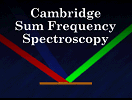|
|
|
Navigation Links |
||
| Home Page |
||
| Latest News |
||
| Group Members |
||
| Research Interests |
||
| Collaborations |
||
| Publications |
||
| Conferences |
||
| Contact Details |
||
| Gallery |
||
| Links |
||
Research InterestsDiode Laser Velocity Modulation Spectroscopy
|

|
|
Summary of Interests |
|
Gas phase molecular ions are amongst the most fascinating species in the field of spectroscopy. They play very important roles in many areas of chemistry and physics. In the upper atmosphere and in interstellar gas clouds, ion-molecule reactions are pre-eminent and account for the formation of many interstellar molecules. Molecular ions also influence the properties of nearly all plasmas, both in the laboratory and in nature. However, acquiring the high resolution spectra of molecular ions is a very challenging task. This situation is exacerbated in the infrared region where ion absorptions are usually overlapped by much stronger absorptions of neutral species. Velocity modulation is a very powerful technique for distinguishing ion signals from neutral species in an ac discharge. The Velocity Modulation Spectrometer is based upon the fact that in an electric discharge ionic species move towards the electrodes leading to observable Doppler shifts to ion absorptions, while absorptions of uncharged species are unaffected. Using an ac discharge and phase sensitive detection allows us to distinguish easily between ions and neutral species. In our group, velocity modulation spectroscopy has produced many important studies of molecular ions including SiH+, SH+, H2O+, SiH3+, Si2-, SiCl+, HBCl+ and HBBr+. More recently we have observed the pure rotation and vibration rotational transitions of HeH+ and HeD+ near the dissociation limit which include a number of transitions involving quasibound states. Work is continuing with the infrared spectra of both silicon, e.g. SiH2+, Si2H3+ etc. and boron containing cations and anions. Recent Publications
D. M. Smith, P. M. Martineau and P. B. Davies, J. Chem. Phys., 96, 1741(1992). P. B. Davies and D. M. Smith, J. Chem. Phys.,100, 6166(1994). Z. Liu and P. B. Davies, Phys. Rev. Lett., 76, 596(1996). Z. Liu and P. B. Davies, J. Chem. Phys., 105, 3443(1996). Z. Liu and P. B. Davies, J. Chem. Phys., 107, 337(1997). Z. Liu and P. B. Davies, Phys. Rev. Lett., 79, 2779(1997). W. Y. Fan, Zhuan Liu and P. B. Davies, J. Mol. Spectrosc. 191, 98(1998). N. T. Hunt, Zhuan Liu and P. B. Davies, Mol. Phys. 97, 205(1999). N. T. Hunt, D. Collet, Zhuan Liu and P. B. Davies, J. Chem. Phys.(In press). |
|
| Return to Top of Page | |